Public Health Report: Agencies, Diseases, and Lifestyle Impacts
VerifiedAdded on 2021/01/02
|8
|2495
|94
Report
AI Summary
This report provides a comprehensive overview of public health, focusing on the roles of various agencies, including the WHO, Public Health England, and NHS England, in determining health levels at local, national, and global scales. It delves into the epidemiology of both infectious and non-infectious diseases, discussing the causes, spread, and potential treatments for conditions like hepatitis C and dementia. The report evaluates the effectiveness of different approaches and strategies used to control diseases, such as screening, immunization, and education. Furthermore, it examines the current priorities and approaches of health services for people with diseases, the relationship between disease prevalence and service requirements, and the impact of current lifestyle choices on future health needs. The report also includes a discussion on the importance of a healthy lifestyle and the consequences of unhealthy habits, emphasizing the need for balanced diets, exercise, and the avoidance of harmful substances. Finally, the report touches upon the prevention, secondary prevention, and tertiary prevention of diseases like tuberculosis.
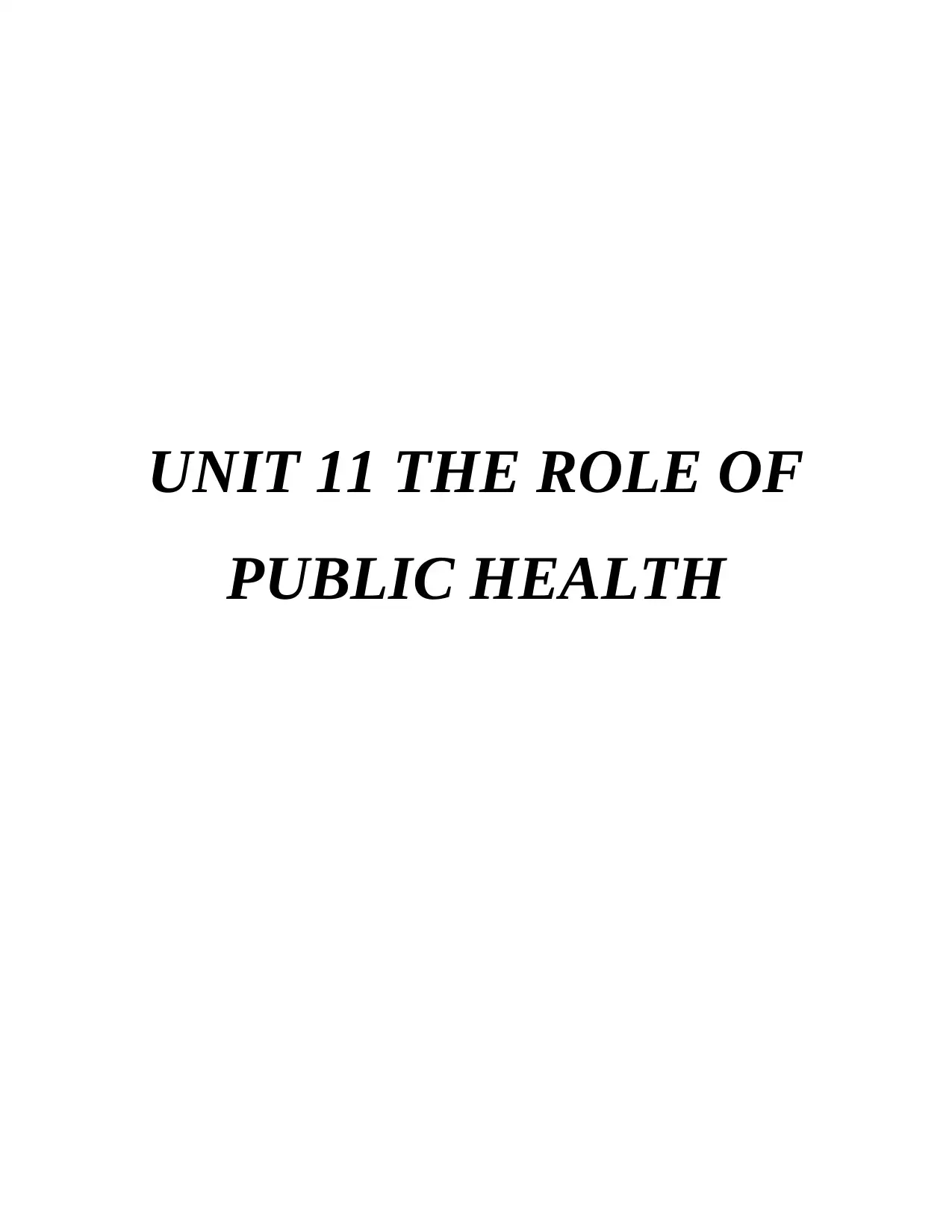
UNIT 11 THE ROLE OF
PUBLIC HEALTH
PUBLIC HEALTH
Paraphrase This Document
Need a fresh take? Get an instant paraphrase of this document with our AI Paraphraser
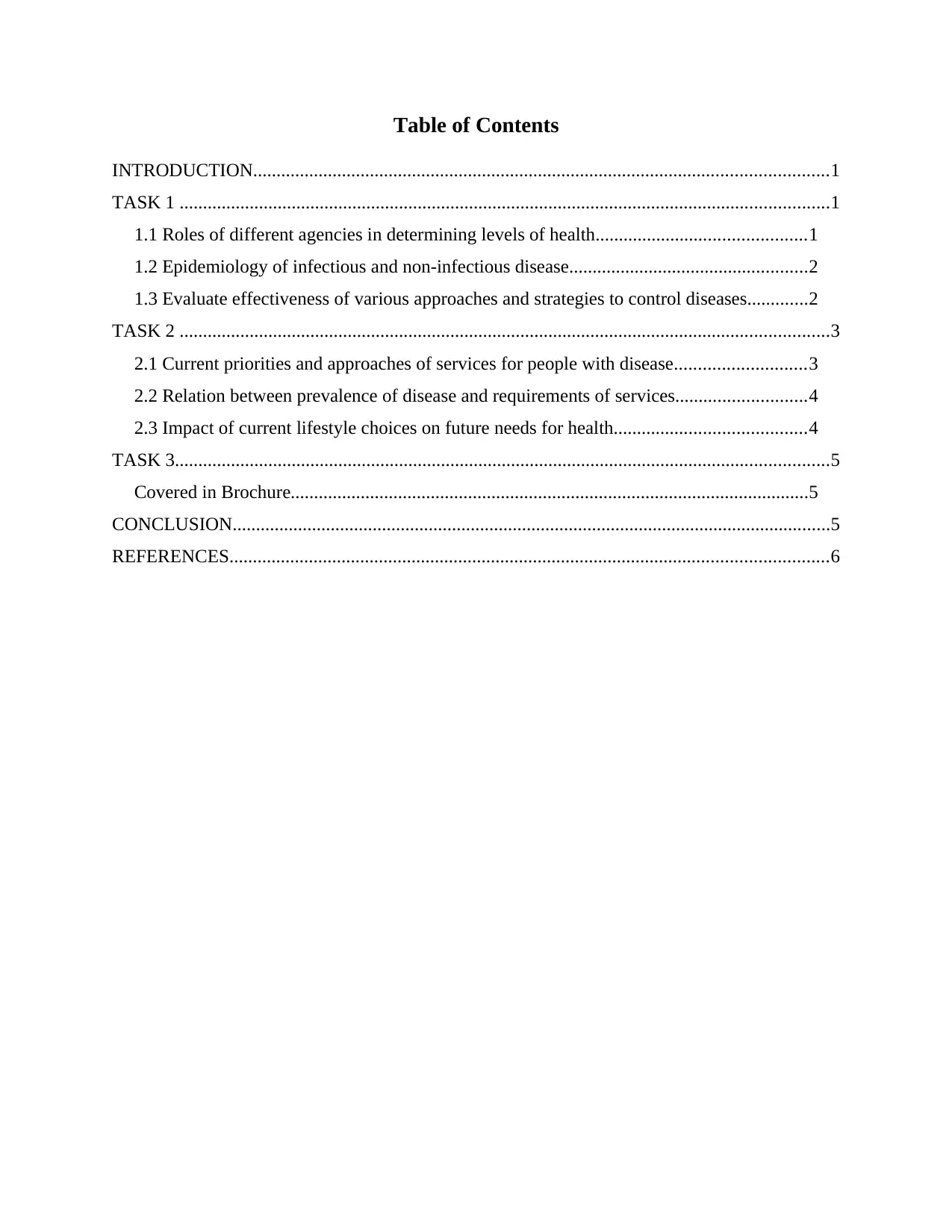
Table of Contents
INTRODUCTION...........................................................................................................................1
TASK 1 ...........................................................................................................................................1
1.1 Roles of different agencies in determining levels of health.............................................1
1.2 Epidemiology of infectious and non-infectious disease...................................................2
1.3 Evaluate effectiveness of various approaches and strategies to control diseases.............2
TASK 2 ...........................................................................................................................................3
2.1 Current priorities and approaches of services for people with disease............................3
2.2 Relation between prevalence of disease and requirements of services............................4
2.3 Impact of current lifestyle choices on future needs for health.........................................4
TASK 3............................................................................................................................................5
Covered in Brochure...............................................................................................................5
CONCLUSION................................................................................................................................5
REFERENCES................................................................................................................................6
INTRODUCTION...........................................................................................................................1
TASK 1 ...........................................................................................................................................1
1.1 Roles of different agencies in determining levels of health.............................................1
1.2 Epidemiology of infectious and non-infectious disease...................................................2
1.3 Evaluate effectiveness of various approaches and strategies to control diseases.............2
TASK 2 ...........................................................................................................................................3
2.1 Current priorities and approaches of services for people with disease............................3
2.2 Relation between prevalence of disease and requirements of services............................4
2.3 Impact of current lifestyle choices on future needs for health.........................................4
TASK 3............................................................................................................................................5
Covered in Brochure...............................................................................................................5
CONCLUSION................................................................................................................................5
REFERENCES................................................................................................................................6
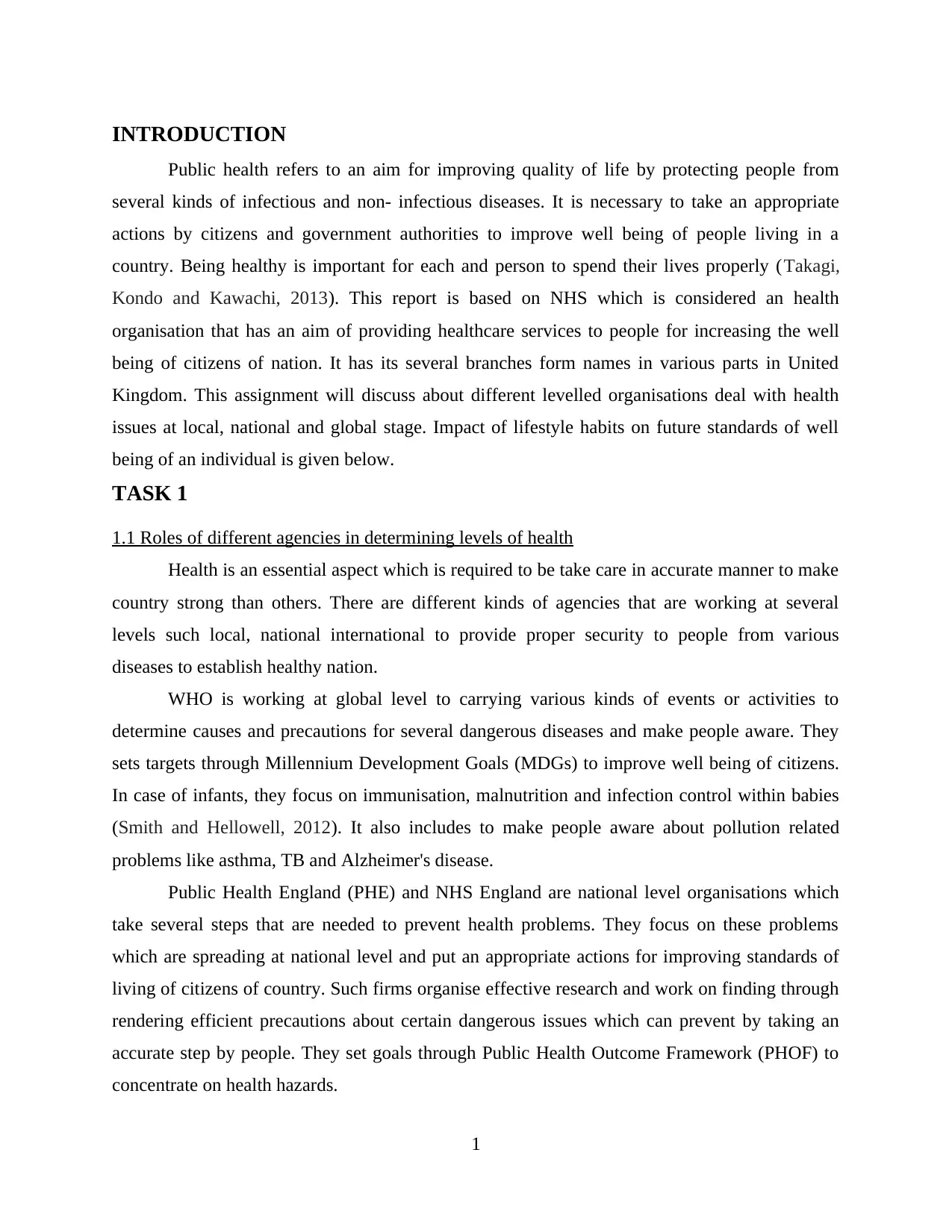
INTRODUCTION
Public health refers to an aim for improving quality of life by protecting people from
several kinds of infectious and non- infectious diseases. It is necessary to take an appropriate
actions by citizens and government authorities to improve well being of people living in a
country. Being healthy is important for each and person to spend their lives properly (Takagi,
Kondo and Kawachi, 2013). This report is based on NHS which is considered an health
organisation that has an aim of providing healthcare services to people for increasing the well
being of citizens of nation. It has its several branches form names in various parts in United
Kingdom. This assignment will discuss about different levelled organisations deal with health
issues at local, national and global stage. Impact of lifestyle habits on future standards of well
being of an individual is given below.
TASK 1
1.1 Roles of different agencies in determining levels of health
Health is an essential aspect which is required to be take care in accurate manner to make
country strong than others. There are different kinds of agencies that are working at several
levels such local, national international to provide proper security to people from various
diseases to establish healthy nation.
WHO is working at global level to carrying various kinds of events or activities to
determine causes and precautions for several dangerous diseases and make people aware. They
sets targets through Millennium Development Goals (MDGs) to improve well being of citizens.
In case of infants, they focus on immunisation, malnutrition and infection control within babies
(Smith and Hellowell, 2012). It also includes to make people aware about pollution related
problems like asthma, TB and Alzheimer's disease.
Public Health England (PHE) and NHS England are national level organisations which
take several steps that are needed to prevent health problems. They focus on these problems
which are spreading at national level and put an appropriate actions for improving standards of
living of citizens of country. Such firms organise effective research and work on finding through
rendering efficient precautions about certain dangerous issues which can prevent by taking an
accurate step by people. They set goals through Public Health Outcome Framework (PHOF) to
concentrate on health hazards.
1
Public health refers to an aim for improving quality of life by protecting people from
several kinds of infectious and non- infectious diseases. It is necessary to take an appropriate
actions by citizens and government authorities to improve well being of people living in a
country. Being healthy is important for each and person to spend their lives properly (Takagi,
Kondo and Kawachi, 2013). This report is based on NHS which is considered an health
organisation that has an aim of providing healthcare services to people for increasing the well
being of citizens of nation. It has its several branches form names in various parts in United
Kingdom. This assignment will discuss about different levelled organisations deal with health
issues at local, national and global stage. Impact of lifestyle habits on future standards of well
being of an individual is given below.
TASK 1
1.1 Roles of different agencies in determining levels of health
Health is an essential aspect which is required to be take care in accurate manner to make
country strong than others. There are different kinds of agencies that are working at several
levels such local, national international to provide proper security to people from various
diseases to establish healthy nation.
WHO is working at global level to carrying various kinds of events or activities to
determine causes and precautions for several dangerous diseases and make people aware. They
sets targets through Millennium Development Goals (MDGs) to improve well being of citizens.
In case of infants, they focus on immunisation, malnutrition and infection control within babies
(Smith and Hellowell, 2012). It also includes to make people aware about pollution related
problems like asthma, TB and Alzheimer's disease.
Public Health England (PHE) and NHS England are national level organisations which
take several steps that are needed to prevent health problems. They focus on these problems
which are spreading at national level and put an appropriate actions for improving standards of
living of citizens of country. Such firms organise effective research and work on finding through
rendering efficient precautions about certain dangerous issues which can prevent by taking an
accurate step by people. They set goals through Public Health Outcome Framework (PHOF) to
concentrate on health hazards.
1
⊘ This is a preview!⊘
Do you want full access?
Subscribe today to unlock all pages.

Trusted by 1+ million students worldwide
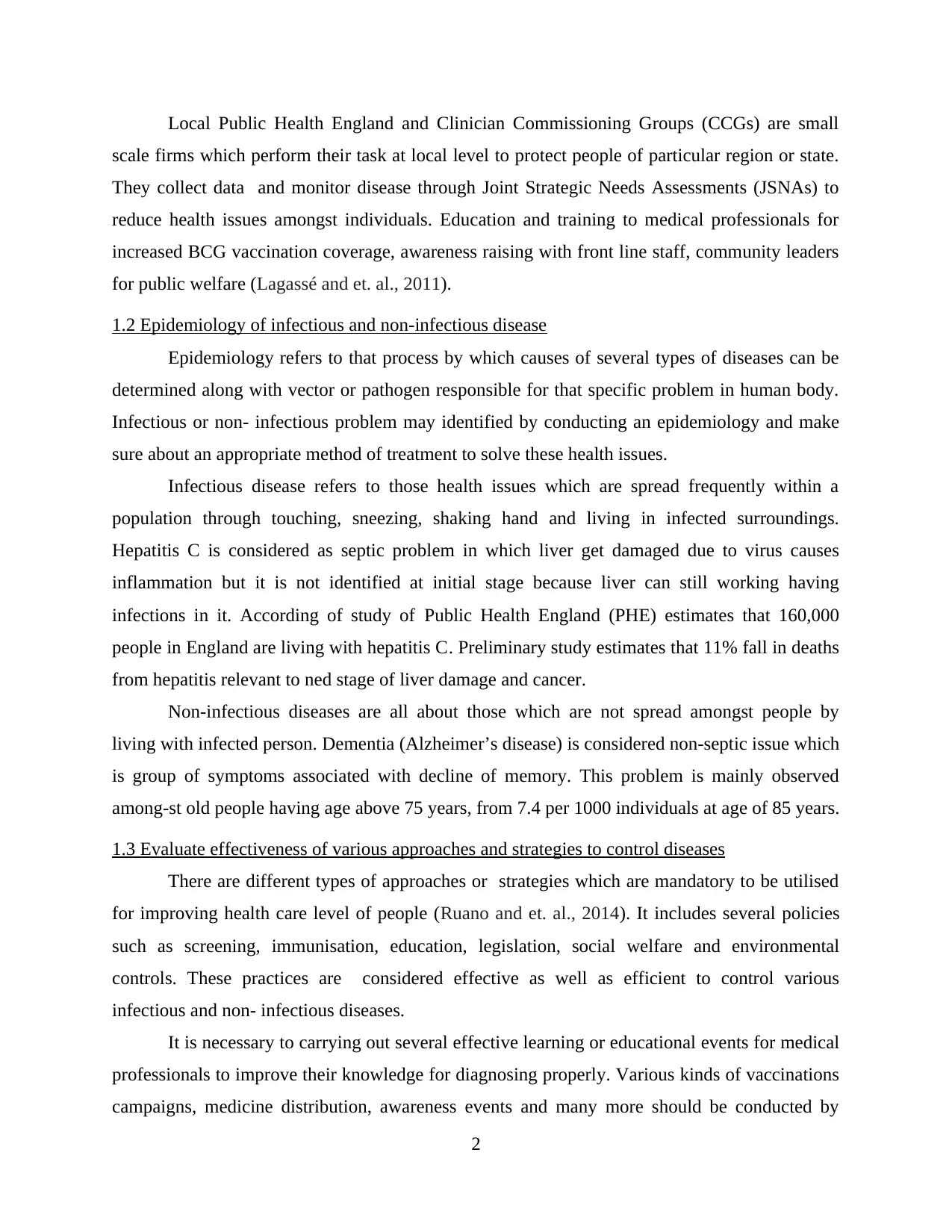
Local Public Health England and Clinician Commissioning Groups (CCGs) are small
scale firms which perform their task at local level to protect people of particular region or state.
They collect data and monitor disease through Joint Strategic Needs Assessments (JSNAs) to
reduce health issues amongst individuals. Education and training to medical professionals for
increased BCG vaccination coverage, awareness raising with front line staff, community leaders
for public welfare (Lagassé and et. al., 2011).
1.2 Epidemiology of infectious and non-infectious disease
Epidemiology refers to that process by which causes of several types of diseases can be
determined along with vector or pathogen responsible for that specific problem in human body.
Infectious or non- infectious problem may identified by conducting an epidemiology and make
sure about an appropriate method of treatment to solve these health issues.
Infectious disease refers to those health issues which are spread frequently within a
population through touching, sneezing, shaking hand and living in infected surroundings.
Hepatitis C is considered as septic problem in which liver get damaged due to virus causes
inflammation but it is not identified at initial stage because liver can still working having
infections in it. According of study of Public Health England (PHE) estimates that 160,000
people in England are living with hepatitis C. Preliminary study estimates that 11% fall in deaths
from hepatitis relevant to ned stage of liver damage and cancer.
Non-infectious diseases are all about those which are not spread amongst people by
living with infected person. Dementia (Alzheimer’s disease) is considered non-septic issue which
is group of symptoms associated with decline of memory. This problem is mainly observed
among-st old people having age above 75 years, from 7.4 per 1000 individuals at age of 85 years.
1.3 Evaluate effectiveness of various approaches and strategies to control diseases
There are different types of approaches or strategies which are mandatory to be utilised
for improving health care level of people (Ruano and et. al., 2014). It includes several policies
such as screening, immunisation, education, legislation, social welfare and environmental
controls. These practices are considered effective as well as efficient to control various
infectious and non- infectious diseases.
It is necessary to carrying out several effective learning or educational events for medical
professionals to improve their knowledge for diagnosing properly. Various kinds of vaccinations
campaigns, medicine distribution, awareness events and many more should be conducted by
2
scale firms which perform their task at local level to protect people of particular region or state.
They collect data and monitor disease through Joint Strategic Needs Assessments (JSNAs) to
reduce health issues amongst individuals. Education and training to medical professionals for
increased BCG vaccination coverage, awareness raising with front line staff, community leaders
for public welfare (Lagassé and et. al., 2011).
1.2 Epidemiology of infectious and non-infectious disease
Epidemiology refers to that process by which causes of several types of diseases can be
determined along with vector or pathogen responsible for that specific problem in human body.
Infectious or non- infectious problem may identified by conducting an epidemiology and make
sure about an appropriate method of treatment to solve these health issues.
Infectious disease refers to those health issues which are spread frequently within a
population through touching, sneezing, shaking hand and living in infected surroundings.
Hepatitis C is considered as septic problem in which liver get damaged due to virus causes
inflammation but it is not identified at initial stage because liver can still working having
infections in it. According of study of Public Health England (PHE) estimates that 160,000
people in England are living with hepatitis C. Preliminary study estimates that 11% fall in deaths
from hepatitis relevant to ned stage of liver damage and cancer.
Non-infectious diseases are all about those which are not spread amongst people by
living with infected person. Dementia (Alzheimer’s disease) is considered non-septic issue which
is group of symptoms associated with decline of memory. This problem is mainly observed
among-st old people having age above 75 years, from 7.4 per 1000 individuals at age of 85 years.
1.3 Evaluate effectiveness of various approaches and strategies to control diseases
There are different types of approaches or strategies which are mandatory to be utilised
for improving health care level of people (Ruano and et. al., 2014). It includes several policies
such as screening, immunisation, education, legislation, social welfare and environmental
controls. These practices are considered effective as well as efficient to control various
infectious and non- infectious diseases.
It is necessary to carrying out several effective learning or educational events for medical
professionals to improve their knowledge for diagnosing properly. Various kinds of vaccinations
campaigns, medicine distribution, awareness events and many more should be conducted by
2
Paraphrase This Document
Need a fresh take? Get an instant paraphrase of this document with our AI Paraphraser
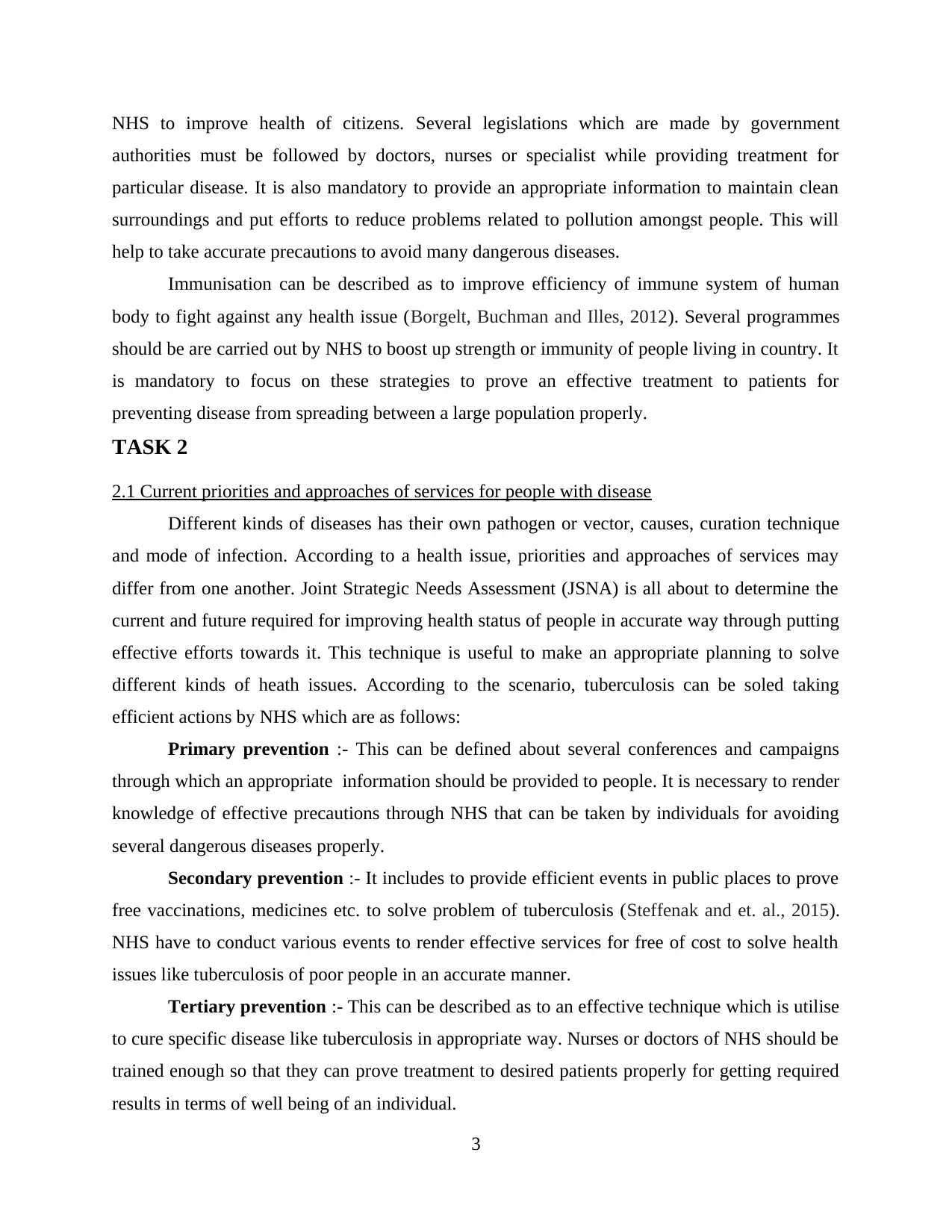
NHS to improve health of citizens. Several legislations which are made by government
authorities must be followed by doctors, nurses or specialist while providing treatment for
particular disease. It is also mandatory to provide an appropriate information to maintain clean
surroundings and put efforts to reduce problems related to pollution amongst people. This will
help to take accurate precautions to avoid many dangerous diseases.
Immunisation can be described as to improve efficiency of immune system of human
body to fight against any health issue (Borgelt, Buchman and Illes, 2012). Several programmes
should be are carried out by NHS to boost up strength or immunity of people living in country. It
is mandatory to focus on these strategies to prove an effective treatment to patients for
preventing disease from spreading between a large population properly.
TASK 2
2.1 Current priorities and approaches of services for people with disease
Different kinds of diseases has their own pathogen or vector, causes, curation technique
and mode of infection. According to a health issue, priorities and approaches of services may
differ from one another. Joint Strategic Needs Assessment (JSNA) is all about to determine the
current and future required for improving health status of people in accurate way through putting
effective efforts towards it. This technique is useful to make an appropriate planning to solve
different kinds of heath issues. According to the scenario, tuberculosis can be soled taking
efficient actions by NHS which are as follows:
Primary prevention :- This can be defined about several conferences and campaigns
through which an appropriate information should be provided to people. It is necessary to render
knowledge of effective precautions through NHS that can be taken by individuals for avoiding
several dangerous diseases properly.
Secondary prevention :- It includes to provide efficient events in public places to prove
free vaccinations, medicines etc. to solve problem of tuberculosis (Steffenak and et. al., 2015).
NHS have to conduct various events to render effective services for free of cost to solve health
issues like tuberculosis of poor people in an accurate manner.
Tertiary prevention :- This can be described as to an effective technique which is utilise
to cure specific disease like tuberculosis in appropriate way. Nurses or doctors of NHS should be
trained enough so that they can prove treatment to desired patients properly for getting required
results in terms of well being of an individual.
3
authorities must be followed by doctors, nurses or specialist while providing treatment for
particular disease. It is also mandatory to provide an appropriate information to maintain clean
surroundings and put efforts to reduce problems related to pollution amongst people. This will
help to take accurate precautions to avoid many dangerous diseases.
Immunisation can be described as to improve efficiency of immune system of human
body to fight against any health issue (Borgelt, Buchman and Illes, 2012). Several programmes
should be are carried out by NHS to boost up strength or immunity of people living in country. It
is mandatory to focus on these strategies to prove an effective treatment to patients for
preventing disease from spreading between a large population properly.
TASK 2
2.1 Current priorities and approaches of services for people with disease
Different kinds of diseases has their own pathogen or vector, causes, curation technique
and mode of infection. According to a health issue, priorities and approaches of services may
differ from one another. Joint Strategic Needs Assessment (JSNA) is all about to determine the
current and future required for improving health status of people in accurate way through putting
effective efforts towards it. This technique is useful to make an appropriate planning to solve
different kinds of heath issues. According to the scenario, tuberculosis can be soled taking
efficient actions by NHS which are as follows:
Primary prevention :- This can be defined about several conferences and campaigns
through which an appropriate information should be provided to people. It is necessary to render
knowledge of effective precautions through NHS that can be taken by individuals for avoiding
several dangerous diseases properly.
Secondary prevention :- It includes to provide efficient events in public places to prove
free vaccinations, medicines etc. to solve problem of tuberculosis (Steffenak and et. al., 2015).
NHS have to conduct various events to render effective services for free of cost to solve health
issues like tuberculosis of poor people in an accurate manner.
Tertiary prevention :- This can be described as to an effective technique which is utilise
to cure specific disease like tuberculosis in appropriate way. Nurses or doctors of NHS should be
trained enough so that they can prove treatment to desired patients properly for getting required
results in terms of well being of an individual.
3
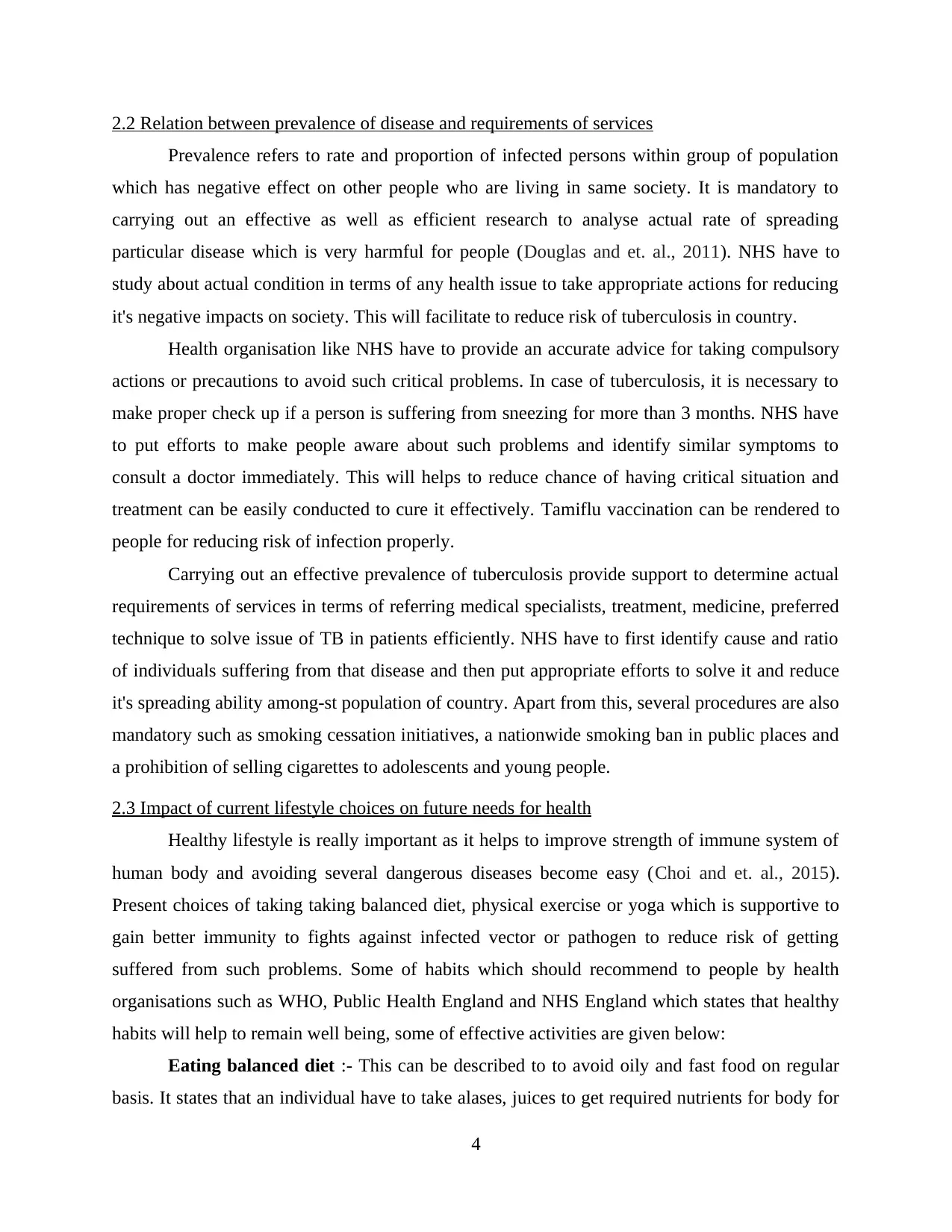
2.2 Relation between prevalence of disease and requirements of services
Prevalence refers to rate and proportion of infected persons within group of population
which has negative effect on other people who are living in same society. It is mandatory to
carrying out an effective as well as efficient research to analyse actual rate of spreading
particular disease which is very harmful for people (Douglas and et. al., 2011). NHS have to
study about actual condition in terms of any health issue to take appropriate actions for reducing
it's negative impacts on society. This will facilitate to reduce risk of tuberculosis in country.
Health organisation like NHS have to provide an accurate advice for taking compulsory
actions or precautions to avoid such critical problems. In case of tuberculosis, it is necessary to
make proper check up if a person is suffering from sneezing for more than 3 months. NHS have
to put efforts to make people aware about such problems and identify similar symptoms to
consult a doctor immediately. This will helps to reduce chance of having critical situation and
treatment can be easily conducted to cure it effectively. Tamiflu vaccination can be rendered to
people for reducing risk of infection properly.
Carrying out an effective prevalence of tuberculosis provide support to determine actual
requirements of services in terms of referring medical specialists, treatment, medicine, preferred
technique to solve issue of TB in patients efficiently. NHS have to first identify cause and ratio
of individuals suffering from that disease and then put appropriate efforts to solve it and reduce
it's spreading ability among-st population of country. Apart from this, several procedures are also
mandatory such as smoking cessation initiatives, a nationwide smoking ban in public places and
a prohibition of selling cigarettes to adolescents and young people.
2.3 Impact of current lifestyle choices on future needs for health
Healthy lifestyle is really important as it helps to improve strength of immune system of
human body and avoiding several dangerous diseases become easy (Choi and et. al., 2015).
Present choices of taking taking balanced diet, physical exercise or yoga which is supportive to
gain better immunity to fights against infected vector or pathogen to reduce risk of getting
suffered from such problems. Some of habits which should recommend to people by health
organisations such as WHO, Public Health England and NHS England which states that healthy
habits will help to remain well being, some of effective activities are given below:
Eating balanced diet :- This can be described to to avoid oily and fast food on regular
basis. It states that an individual have to take alases, juices to get required nutrients for body for
4
Prevalence refers to rate and proportion of infected persons within group of population
which has negative effect on other people who are living in same society. It is mandatory to
carrying out an effective as well as efficient research to analyse actual rate of spreading
particular disease which is very harmful for people (Douglas and et. al., 2011). NHS have to
study about actual condition in terms of any health issue to take appropriate actions for reducing
it's negative impacts on society. This will facilitate to reduce risk of tuberculosis in country.
Health organisation like NHS have to provide an accurate advice for taking compulsory
actions or precautions to avoid such critical problems. In case of tuberculosis, it is necessary to
make proper check up if a person is suffering from sneezing for more than 3 months. NHS have
to put efforts to make people aware about such problems and identify similar symptoms to
consult a doctor immediately. This will helps to reduce chance of having critical situation and
treatment can be easily conducted to cure it effectively. Tamiflu vaccination can be rendered to
people for reducing risk of infection properly.
Carrying out an effective prevalence of tuberculosis provide support to determine actual
requirements of services in terms of referring medical specialists, treatment, medicine, preferred
technique to solve issue of TB in patients efficiently. NHS have to first identify cause and ratio
of individuals suffering from that disease and then put appropriate efforts to solve it and reduce
it's spreading ability among-st population of country. Apart from this, several procedures are also
mandatory such as smoking cessation initiatives, a nationwide smoking ban in public places and
a prohibition of selling cigarettes to adolescents and young people.
2.3 Impact of current lifestyle choices on future needs for health
Healthy lifestyle is really important as it helps to improve strength of immune system of
human body and avoiding several dangerous diseases become easy (Choi and et. al., 2015).
Present choices of taking taking balanced diet, physical exercise or yoga which is supportive to
gain better immunity to fights against infected vector or pathogen to reduce risk of getting
suffered from such problems. Some of habits which should recommend to people by health
organisations such as WHO, Public Health England and NHS England which states that healthy
habits will help to remain well being, some of effective activities are given below:
Eating balanced diet :- This can be described to to avoid oily and fast food on regular
basis. It states that an individual have to take alases, juices to get required nutrients for body for
4
⊘ This is a preview!⊘
Do you want full access?
Subscribe today to unlock all pages.

Trusted by 1+ million students worldwide
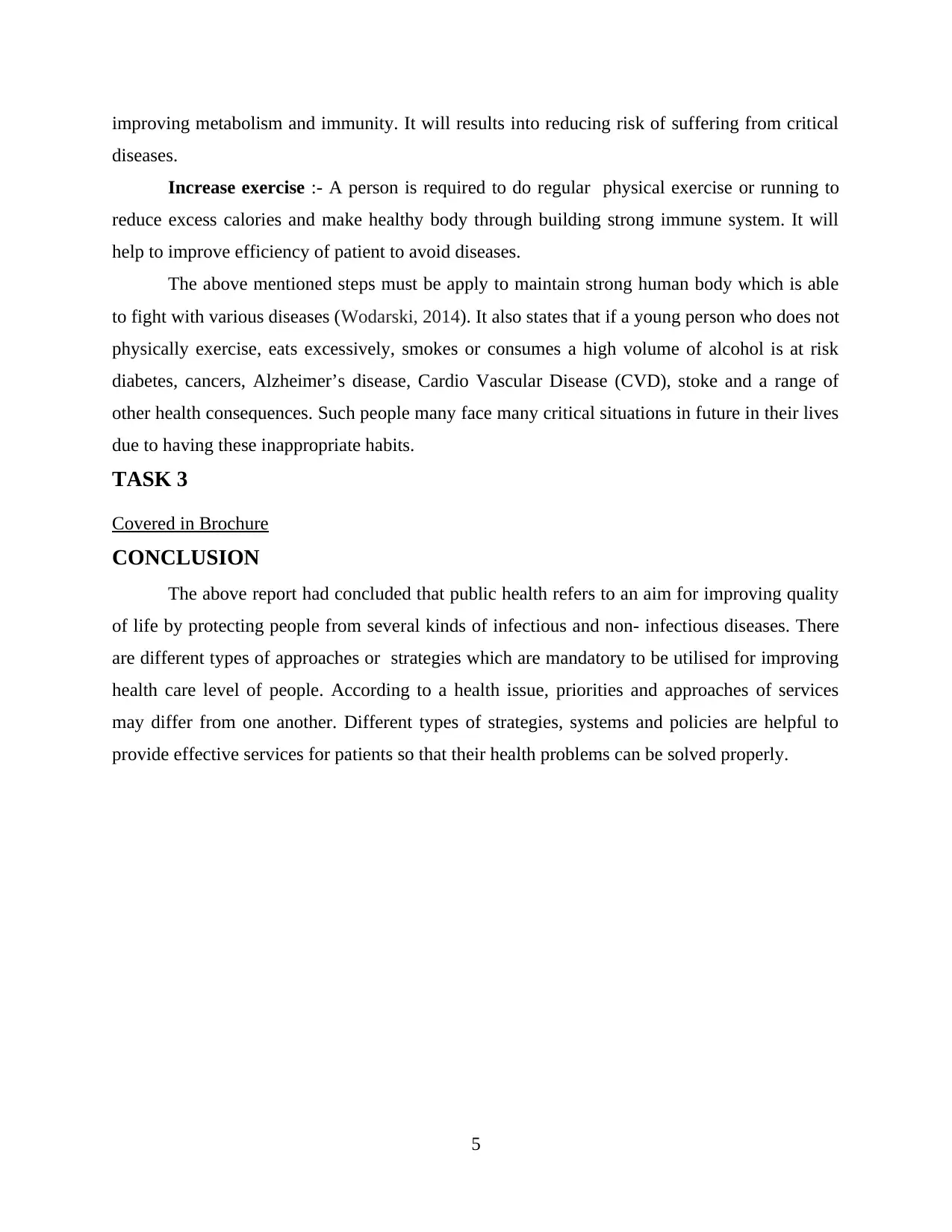
improving metabolism and immunity. It will results into reducing risk of suffering from critical
diseases.
Increase exercise :- A person is required to do regular physical exercise or running to
reduce excess calories and make healthy body through building strong immune system. It will
help to improve efficiency of patient to avoid diseases.
The above mentioned steps must be apply to maintain strong human body which is able
to fight with various diseases (Wodarski, 2014). It also states that if a young person who does not
physically exercise, eats excessively, smokes or consumes a high volume of alcohol is at risk
diabetes, cancers, Alzheimer’s disease, Cardio Vascular Disease (CVD), stoke and a range of
other health consequences. Such people many face many critical situations in future in their lives
due to having these inappropriate habits.
TASK 3
Covered in Brochure
CONCLUSION
The above report had concluded that public health refers to an aim for improving quality
of life by protecting people from several kinds of infectious and non- infectious diseases. There
are different types of approaches or strategies which are mandatory to be utilised for improving
health care level of people. According to a health issue, priorities and approaches of services
may differ from one another. Different types of strategies, systems and policies are helpful to
provide effective services for patients so that their health problems can be solved properly.
5
diseases.
Increase exercise :- A person is required to do regular physical exercise or running to
reduce excess calories and make healthy body through building strong immune system. It will
help to improve efficiency of patient to avoid diseases.
The above mentioned steps must be apply to maintain strong human body which is able
to fight with various diseases (Wodarski, 2014). It also states that if a young person who does not
physically exercise, eats excessively, smokes or consumes a high volume of alcohol is at risk
diabetes, cancers, Alzheimer’s disease, Cardio Vascular Disease (CVD), stoke and a range of
other health consequences. Such people many face many critical situations in future in their lives
due to having these inappropriate habits.
TASK 3
Covered in Brochure
CONCLUSION
The above report had concluded that public health refers to an aim for improving quality
of life by protecting people from several kinds of infectious and non- infectious diseases. There
are different types of approaches or strategies which are mandatory to be utilised for improving
health care level of people. According to a health issue, priorities and approaches of services
may differ from one another. Different types of strategies, systems and policies are helpful to
provide effective services for patients so that their health problems can be solved properly.
5
Paraphrase This Document
Need a fresh take? Get an instant paraphrase of this document with our AI Paraphraser
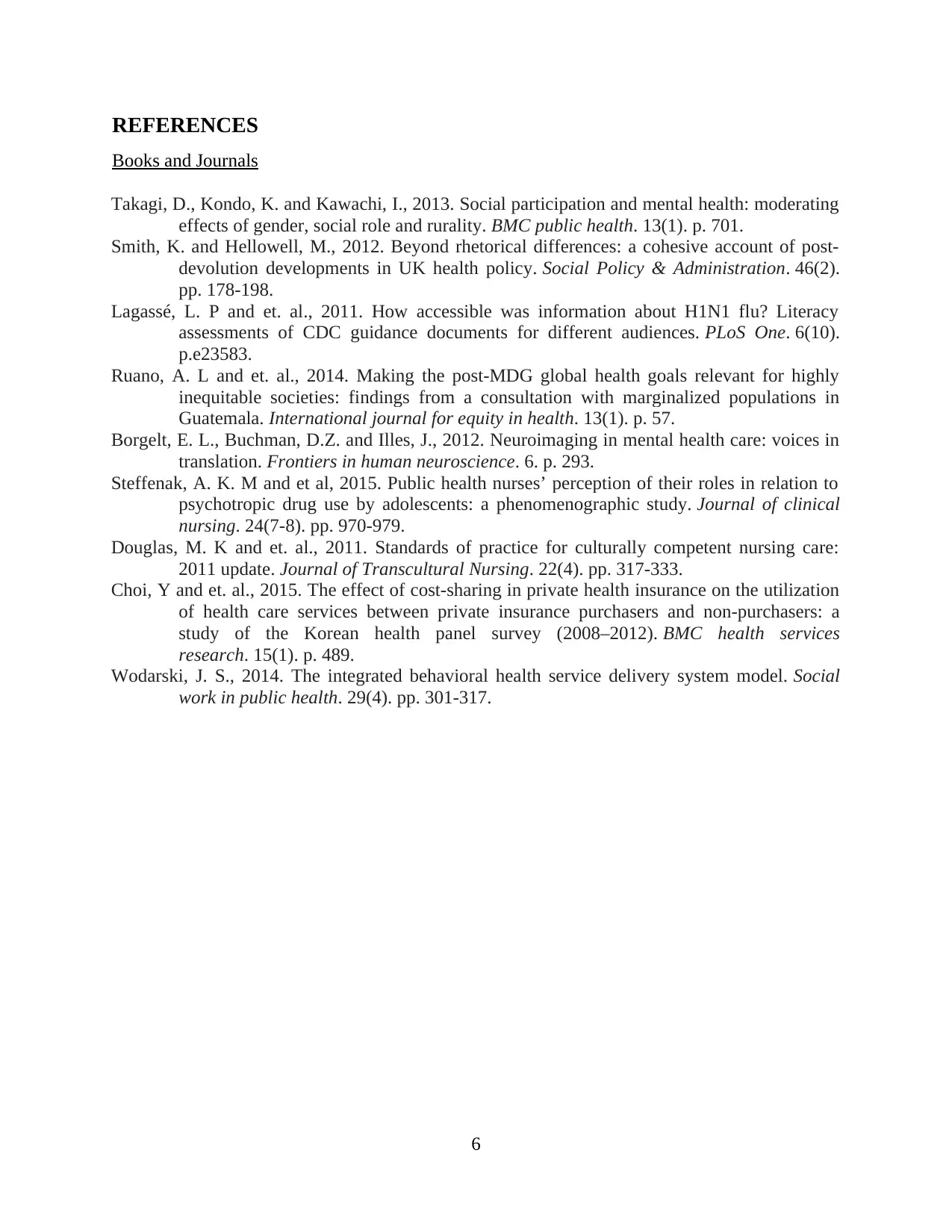
REFERENCES
Books and Journals
Takagi, D., Kondo, K. and Kawachi, I., 2013. Social participation and mental health: moderating
effects of gender, social role and rurality. BMC public health. 13(1). p. 701.
Smith, K. and Hellowell, M., 2012. Beyond rhetorical differences: a cohesive account of post‐
devolution developments in UK health policy. Social Policy & Administration. 46(2).
pp. 178-198.
Lagassé, L. P and et. al., 2011. How accessible was information about H1N1 flu? Literacy
assessments of CDC guidance documents for different audiences. PLoS One. 6(10).
p.e23583.
Ruano, A. L and et. al., 2014. Making the post-MDG global health goals relevant for highly
inequitable societies: findings from a consultation with marginalized populations in
Guatemala. International journal for equity in health. 13(1). p. 57.
Borgelt, E. L., Buchman, D.Z. and Illes, J., 2012. Neuroimaging in mental health care: voices in
translation. Frontiers in human neuroscience. 6. p. 293.
Steffenak, A. K. M and et al, 2015. Public health nurses’ perception of their roles in relation to
psychotropic drug use by adolescents: a phenomenographic study. Journal of clinical
nursing. 24(7-8). pp. 970-979.
Douglas, M. K and et. al., 2011. Standards of practice for culturally competent nursing care:
2011 update. Journal of Transcultural Nursing. 22(4). pp. 317-333.
Choi, Y and et. al., 2015. The effect of cost-sharing in private health insurance on the utilization
of health care services between private insurance purchasers and non-purchasers: a
study of the Korean health panel survey (2008–2012). BMC health services
research. 15(1). p. 489.
Wodarski, J. S., 2014. The integrated behavioral health service delivery system model. Social
work in public health. 29(4). pp. 301-317.
6
Books and Journals
Takagi, D., Kondo, K. and Kawachi, I., 2013. Social participation and mental health: moderating
effects of gender, social role and rurality. BMC public health. 13(1). p. 701.
Smith, K. and Hellowell, M., 2012. Beyond rhetorical differences: a cohesive account of post‐
devolution developments in UK health policy. Social Policy & Administration. 46(2).
pp. 178-198.
Lagassé, L. P and et. al., 2011. How accessible was information about H1N1 flu? Literacy
assessments of CDC guidance documents for different audiences. PLoS One. 6(10).
p.e23583.
Ruano, A. L and et. al., 2014. Making the post-MDG global health goals relevant for highly
inequitable societies: findings from a consultation with marginalized populations in
Guatemala. International journal for equity in health. 13(1). p. 57.
Borgelt, E. L., Buchman, D.Z. and Illes, J., 2012. Neuroimaging in mental health care: voices in
translation. Frontiers in human neuroscience. 6. p. 293.
Steffenak, A. K. M and et al, 2015. Public health nurses’ perception of their roles in relation to
psychotropic drug use by adolescents: a phenomenographic study. Journal of clinical
nursing. 24(7-8). pp. 970-979.
Douglas, M. K and et. al., 2011. Standards of practice for culturally competent nursing care:
2011 update. Journal of Transcultural Nursing. 22(4). pp. 317-333.
Choi, Y and et. al., 2015. The effect of cost-sharing in private health insurance on the utilization
of health care services between private insurance purchasers and non-purchasers: a
study of the Korean health panel survey (2008–2012). BMC health services
research. 15(1). p. 489.
Wodarski, J. S., 2014. The integrated behavioral health service delivery system model. Social
work in public health. 29(4). pp. 301-317.
6
1 out of 8
Related Documents
Your All-in-One AI-Powered Toolkit for Academic Success.
+13062052269
info@desklib.com
Available 24*7 on WhatsApp / Email
![[object Object]](/_next/static/media/star-bottom.7253800d.svg)
Unlock your academic potential
Copyright © 2020–2025 A2Z Services. All Rights Reserved. Developed and managed by ZUCOL.





